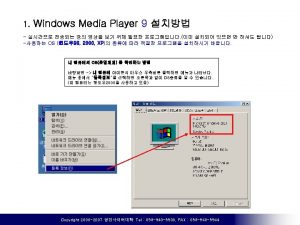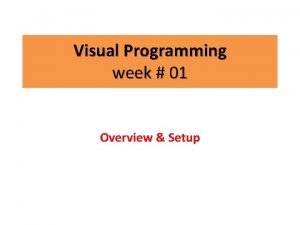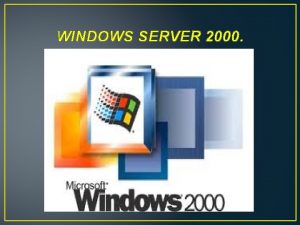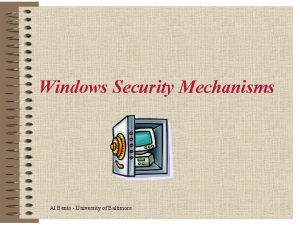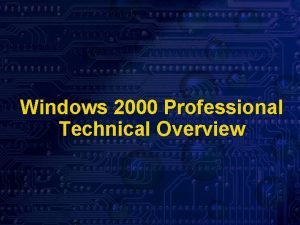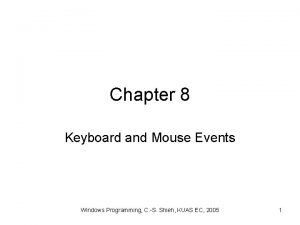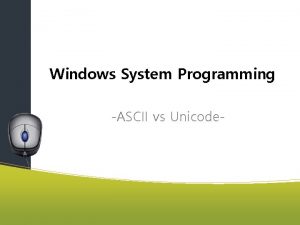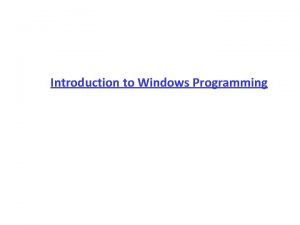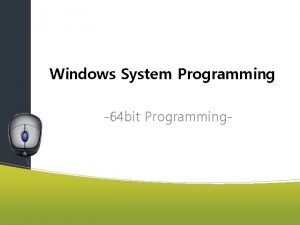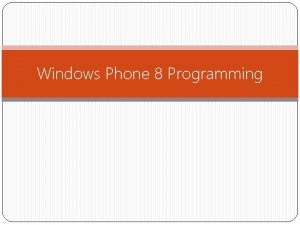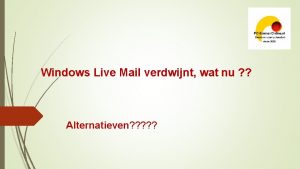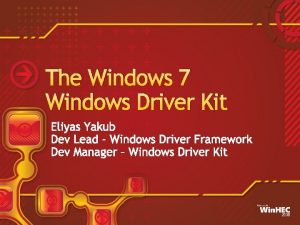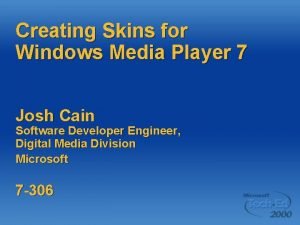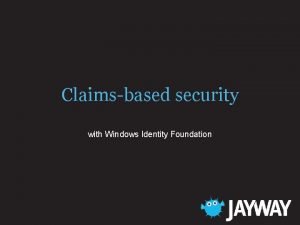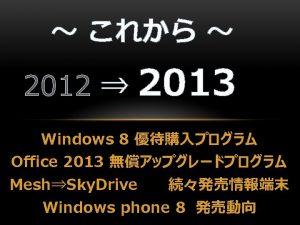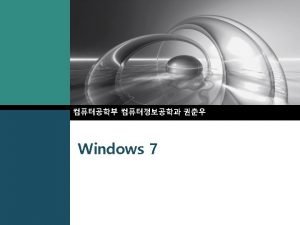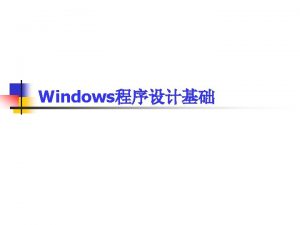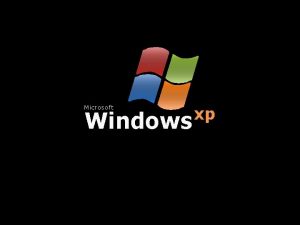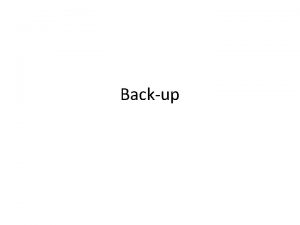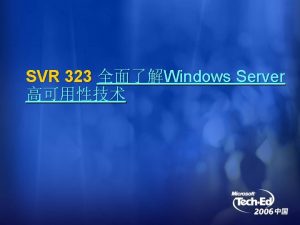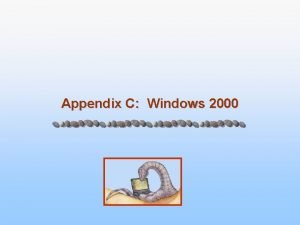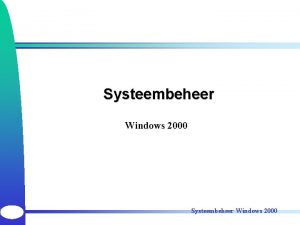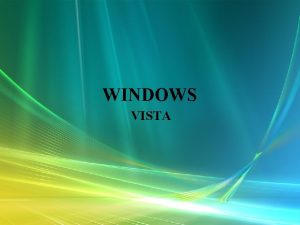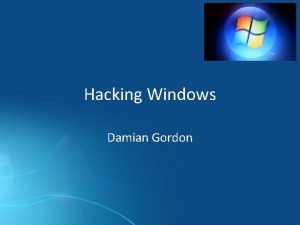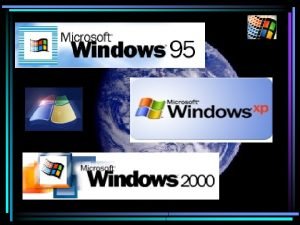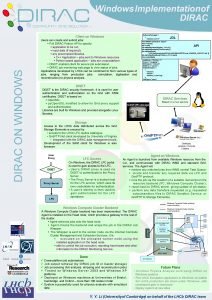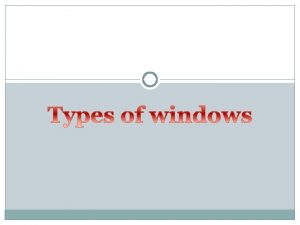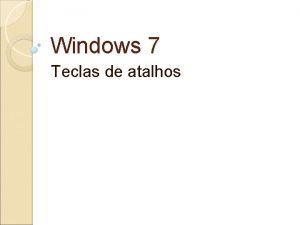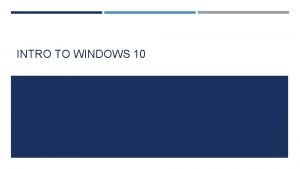Chapter 8 Windows 2000 Outline Programming Windows 2000


























- Slides: 26

Chapter 8 Windows 2000

Outline • • • Programming Windows 2000 System structure Processes and threads in Windows 2000 Memory management The Windows 2000 file system 2

Microsoft Operating Systems • Command-line oriented systems – MS-DOS • Consumer Windows – Windows 95/98/Me • Windows NT • Windows 2000 = Windows NT 5. 0 3

Win 32 API • Library procedures making system calls or do the work right in user space • Provide a very comprehensive interface – Multiple ways of doing the same thing – Include many non-system call functions • Not every version of Windows implements every call – Sometimes there are minor differences, e. g. , parameters 4

The Registry • A big central database in Windows – Keep all infomation for booting and configuring the system and tailoring it to current user • A file system for very small files – Keys, subkeys: directories – Value: files • Each value has three parts: a name, a type, and the data • Stored in files called hives – Most are under winntsystem 32config 5

Outline • • • Programming Windows 2000 System structure Processes and threads in Windows 2000 Memory management The Windows 2000 file system 6

Operating System Structure • OS itself running in kernel mode – Process management – Memory management – File system • Environment subsystem in user mode • Client-server model 7

The Structure of Windows 2000 8

HAL and Kernel • HAL: present the rest of OS with abstract hardware devices • Kernel: make the rest of OS completely independent of the hardware – Provide low-level support for control objects and dispatcher objects – Control objects: control the system • e. g. , primitive process objects, interrupt objects – Dispatcher objects: objects threads can wait on • Semaphores, mutexes, events, waitable timers, … 9

Executive and System Services • 10 components – Object, I/O, process, memory, security, cache, plug-and-play, power, configuration, local procedure call • Each component is a collection of procedures • GDI (graphics device interface) handles image management for monitor and printers • System Services: provide an interface to executive 10

Implementation of Objects • A uniform and consistent interface to all system sources and data structures • Some number of consecutive words in mem – A data structure in RAM 11

Handle Table, Objects and Type Objects 12

Environment Subsystem • DLLs + environment subsystem: implement the functionality of published interface – Win 32, POSIX and OS/2 – Hide the true system call interface from app • DLL (dynamic linked library) – Share common library calls, linked at runtime 13

Outline • • • Programming Windows 2000 System structure Processes and threads in Windows 2000 Memory management The Windows 2000 file system 14

Basic Concepts • Job: collection of processes that share quotas and limits • Process: container for holding resources – 4 G address space, bottom 2 G for user – OS is present in every process’ address • Thread: unit of CPU scheduling – Threads (not processes) have states – Some daemon threads in kernel space – Thread switching enters kernel mode • Fiber: lightweight thread managed in user space – One thread has multiple fiber 15

Interprocess Communication • Mailslots: similar to pipe in UNIX – One way, no guaranteed delivery, can have multiple receivers • • Sockets: pipes often across machines Remote procedure calls Share memory by mapping on to same file Synchronization mechanisms – Semaphores, mutexes, critical regions, events – They work on threads, not on processes 16

Create A Process • Create. Process call in Win 32 • Examine and open the executable file as a parameter (user mode in kernel 32. dll) • Call Nt. Create. Process, create empty process kernel and executive objects, initialization • Call Nt. Create. Thread, create the initial thread • Pass the process/thread handles to Win 32 environment • Start the initial thread, complete initialization • Set priority, etc, rune the code of the process 17

Scheduling in Windows 2000 • No central scheduling thread • Current thread executes scheduler code – The thread blocks on a semaphore, mutex, I/O (kernel mode) – The thread signals an object (kernel mode) – The running thread’s quantum expires (trap to kernel) 18

Priorities of Threads (0 -31) Win 32 process class priorities Win 32 thread priority Real time High Above Below Normal Idle normal Time critical 31 15 15 15 Highest 26 15 12 10 8 6 Above normal 25 14 11 9 7 5 Normal 24 13 10 8 6 4 Below normal 23 12 9 7 5 3 Lowest 22 11 8 6 4 2 Idle 16 1 1 19

Scheduling • An array of 32 queues of threads – Scheduling is based on threads • The thread with highest priority runs next – When multiple threads ready at the highest priority level, they run round robin for one quantum each – When quantum expires, the thread goes to the end of the queue 20

Outline • • • Programming Windows 2000 System structure Processes and threads in Windows 2000 Memory management The Windows 2000 file system 21

Virtual Address Space 22

Pros and Cons of Virtual Space • OS and user program are put into one virtual address space • A thread traps into kernel mode and keeps on running in the same thread in system call – Only need to switch to the thread’s kernel stack • Faster system calls • Less private address space per process 23

Paging • No pre-paging at all • Paging is based on processes, not threads • For each process, maintain the working set – Minimum/maximum size to control the set • Working set manager checks working set quotas and # of free pages once a second 24

Outline • • • Programming Windows 2000 System structure Processes and threads in Windows 2000 Memory management The Windows 2000 file system 25

NTFS File System • A highly complex and sophisticated system • A NTFS file is a set of streams – Name, object ID, (multiple) data streams – Word processing, two versions of a document • Temporary one (named): in use during editing • Final one (unnamed): the user is done – Both streams share a file name, security info, timestamp, etc. • Win 32 function calls are roughly similar to their UNIX counterparts 26
 Windows media player 9 windows 2000
Windows media player 9 windows 2000 Flavorful sentence
Flavorful sentence Visual programming course outline
Visual programming course outline Perbedaan linear programming dan integer programming
Perbedaan linear programming dan integer programming Greedy vs dynamic programming
Greedy vs dynamic programming Components of system programming
Components of system programming Linear vs integer programming
Linear vs integer programming Perbedaan linear programming dan integer programming
Perbedaan linear programming dan integer programming Windows server 2000 caracteristicas
Windows server 2000 caracteristicas Bento windows 8
Bento windows 8 Sistema operativo windows 2000
Sistema operativo windows 2000 Sysprep windows 2000
Sysprep windows 2000 Windows mouse events
Windows mouse events Four special cases in linear programming
Four special cases in linear programming Ascii table windows
Ascii table windows Introduction to windows programming
Introduction to windows programming Windows system programming
Windows system programming Visual studio
Visual studio How to increase audio volume in windows movie maker
How to increase audio volume in windows movie maker Alternatief voor windows live mail
Alternatief voor windows live mail Windows driver kit windows 7
Windows driver kit windows 7 Windows movie maker download microsoft
Windows movie maker download microsoft Skins for media player
Skins for media player Windows identity foundation windows 10
Windows identity foundation windows 10 Upgrade windows 7 to windows 10
Upgrade windows 7 to windows 10 How to install windows xp in virtualbox
How to install windows xp in virtualbox Nokia lumia 920 windows 10
Nokia lumia 920 windows 10
